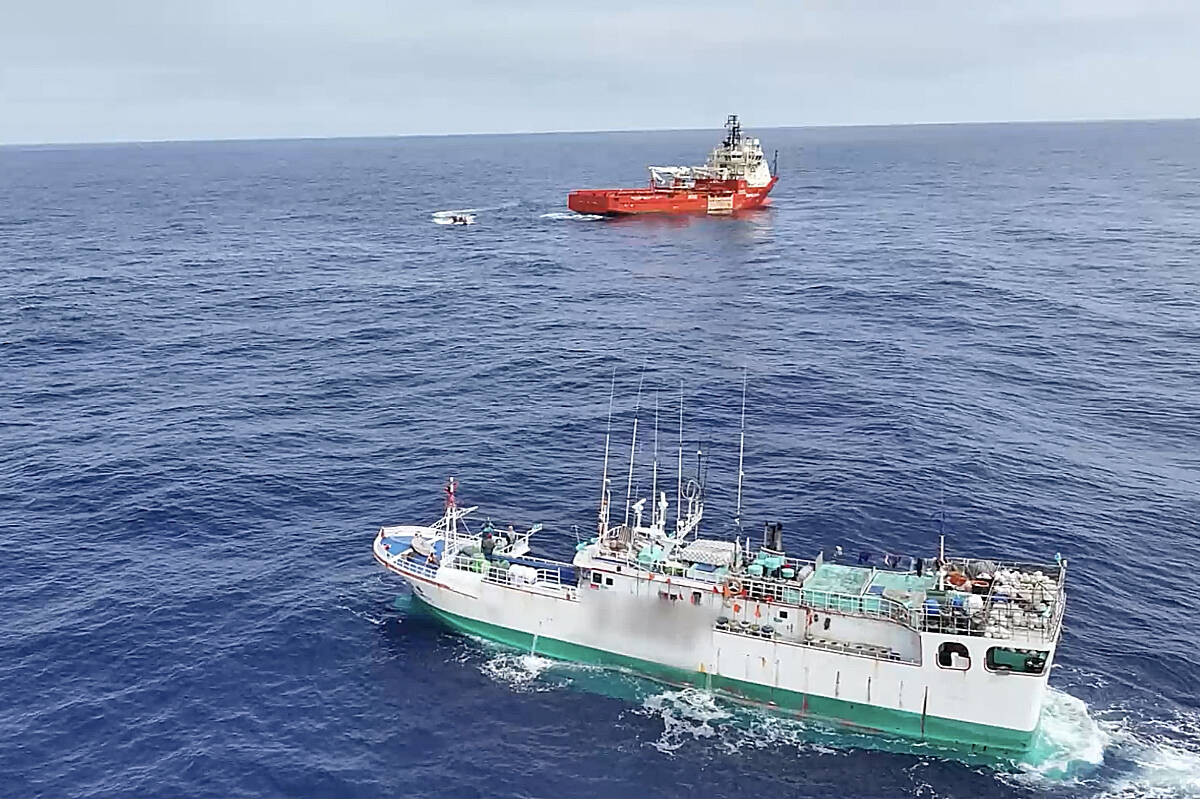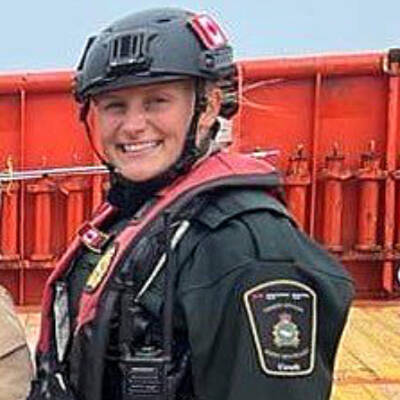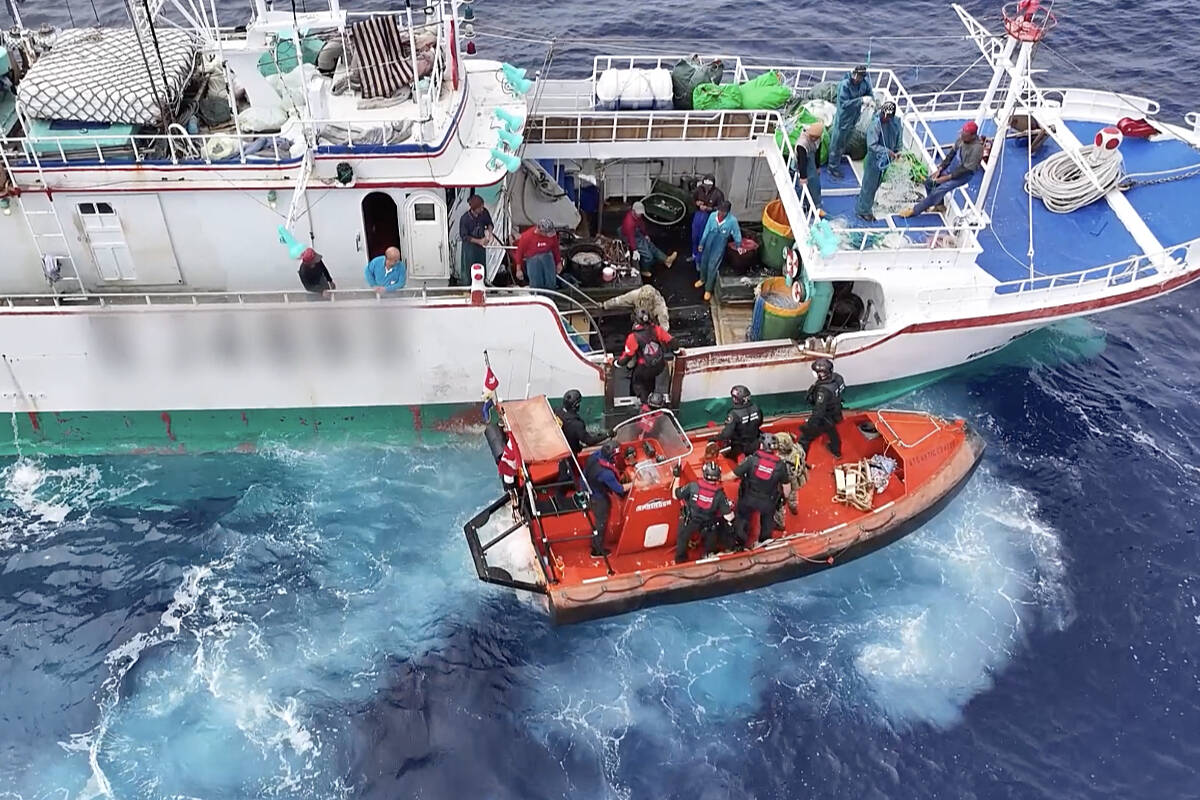Fishery officer Jessica Bouwers’ effort to climb aboard a vessel heaving from three-metre waves was a tiny speck of human drama playing out on the vast expanse of the North Pacific Ocean.
But it exemplified the determined effort she, fellow Canadian fishery officers and U.S Coast Guard officers put into enforcing international fishing regulations and protecting global fish stocks during Operation North Pacific Guard.
“There was one day we had two-and-a-half to three-metre seas,” Bouwers said. “So, that’s like almost 10-foot waves (while) you’re trying to board a vessel from a smaller vessel. You’ve really got to commit to sticking onto that ladder. You don’t want to end up in the middle of the ocean bobbing around.”
Bouwers, 29, is happy she’s “nimble enough to get up all the ladders and all the other things that we need to do.”
Her efforts were made as part of the first Canadian-led high seas patrol to detect and deter illegal, unreported and unregulated (IUU) fishing in the North Pacific. Conducted in September and October, Operation North Pacific Guard is an annual, multi-national effort to coordinate fisheries enforcement to protect global fish stocks. Canada’s efforts included ship, satellite and air surveillance, supported by personnel from the Canadian Coast Guard and DFO, officers from the United States Coast Guard (USCG) and the National Oceanic and Atmospheric Administration (NOAA).
For two months, officers and support personnel patrolled over 12,000 nautical miles on the chartered vessel, the 70-metre Atlantic Condor, the equivalent of travelling half-way around the world. The goal of the mission was to find illegal high seas driftnets, illegal fishing activity and inspect fishing vessels under international law to ensure compliance with fisheries regulations.
This is the second of these types of missions that Bouwers has been involved in. She participated in a North Pacific Guard patrol that was led by the U.S. Coast Guard in 2021. This year’s mission was the first time Canada has led a sea-based patrol and she seems proud of it.
“It’s usually led by the U.S. Coast Guard or any of the other partner countries under the North Pacific Fisheries Commission or the Western Pacific Fisheries Commission,” she said. “Yeah, it was a big deal for us to be able to go out and be the lead in enforcing all the rules out there.
“I really wanted to be involved, because it was Canadian led. I know a lot of the fisheries officers that were deployed on this as well. And it was super cool to be able to see my colleagues be the ones that kind of kickstart this whole thing.”
Officers involved in the mission boarded vessels to conduct inspections, interacting with over 400 crew members from different nations onboard the vessels.
There are over 1,200 vessels registered to fish in the high seas, Bouwers said. Her team boarded 10, a second patrol boarded another 10 while the aircraft involved observed 300.
“So, if there’s 1,200 vessels out in the sea and we are boarding a small fraction of them…,” Bowers said. “We’ve found issues on the log of vessels we’re on, so that tells you how many issues are actually happening over the entire fleet.”
On her leg of the patrol, Bouwers was on a team of seven Canadian fishery officers, one U.S. Coast Guard interpreter, and two U.S. Coast Guard boarding officers.
The vessels are boarded and then inspections are undertaken to ensure there was no illegal “shark finning” happening. Shark finning involves cutting the valuable fins off shark species and disposing of the carcasses.
The vessels’ documents were also inspected to make sure they were authorized and allowed to be out there fishing and that they were complying with regulations. The boarding party also did DNA swabbing of the decks and other apparatus involved in harvesting in the fishing zone. The DNA samples were sent to the Pacific Biological Station in Nanaimo to see if any of the salmon being caught is Canadian salmon.
The patrols are also watching out for driftnets. Driftnet fishing has been banned since 2008.
An area of particular interest for Bouwers is inspection of living and working conditions for the crews who are at sea for months at a time after being hired by fishing agents. These agents send them out under a certain contract and then sometimes lose touch with them.
“They may or may not be getting paid. They may or may not be able to have contact with their family or friends at home,” Bouwers said. “Those are really important things for me.”
In 2021, Bouwers had talked to one crew member who had been at sea for three years straight but was supposed to be on a one-year contract.
“It’s kind of difficult to know if people are actually being treated fairly,” she said.
Bouwers said it’s important that Canadians be aware of what’s going on beyond our 200-nautical-mile limit.
“So I think there’s a lot of interest for us to see what’s happening with fishing way offshore,” she said.
We should be paying attention to the catching of apex predators like sharks and what impact that has on all lower-level species. In addition, it’s been proven that Canadian salmon stocks migrate further out to see than previously believed. They’ve been found far beyond Canada’s 200 mile limit and that means its plausible that they could be caught by anyone else outside our 200 nautical mile limit and therefore be out of the reach of Canadian fishery management rules.
“So doing the Western Pacific Fishery Commission and North Pacific Fisheries Commission gives us the opportunity to enforce regulations on non-retention of salmon in the high seas.”
During this year’s mission, Canadian officers discovered over 3,000 illegally-possessed or stored shark fins, including threatened species such as ocean whitetip shark and documented incidents of marine pollution, among other violations.
Canada also conducted air surveillance based out of Japan in support of Operation North Pacific Guard. Information from this air patrol was shared with enforcement partners in Japan and the United States.
Canada is now working with the appropriate flag states to support further investigations and sanctions on offending vessels, including providing evidence for 58 violations detected during these patrols. Should the flag-state response to the violations fail to satisfy members, the relevant international commission may ban the vessel from fishing.
IUU fishing is a major contributor to declining fish stocks and the destruction of marine ecosystems globally and undermines the livelihoods of legitimate fish harvesters around the globe. This illegal activity poses a risk to salmon populations in the North Pacific Ocean and is considered to be a potential driver of Pacific salmon declines.
DFOFisheries and Oceans CanadaFishing




